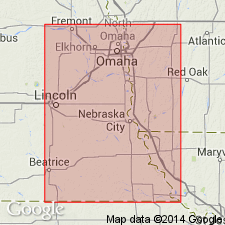
- Usage in publication:
-
- Big Springs limestone bed
- Modifications:
-
- Original reference
- Dominant lithology:
-
- Limestone
- AAPG geologic province:
-
- Forest City basin
Summary:
Pg. 44, 47. Big Springs limestone bed of Lecompton limestone member of Shawnee formation. Bluish gray to light gray, massive, jointed, and quite fossiliferous (fusulinids). Thickness 1 to 3 feet. Overlies Doniphan shale and underlies Queen Hill shale, all included in Lecompton limestone. Recognized in southeastern Nebraska, southwestern Iowa, northwestern Missouri, and northeastern Kansas. Age is Late Pennsylvanian (Missouri age). Report includes cross sections, measured sections, geologic maps, stratigraphic tables.
Exposed near Big Springs, Kansas [north of Big Springs, Douglas Co., northeastern KS (Condra, 1937).]
Source: US geologic names lexicon (USGS Bull. 896, p. 187); GNC KS-NE Pennsylvanian Corr. Chart, sheet 1, Oct. 1936; supplemental information from GNU records (USGS DDS-6; Denver GNULEX).
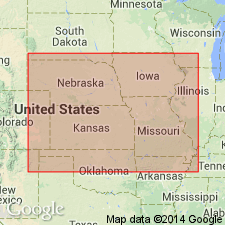
- Usage in publication:
-
- Big Springs limestone member
- Modifications:
-
- Revised
Summary:
Pg. 2035 (fig. 5). Also, R.C. Moore, 1949, Kansas Geol. Survey Bull., no. 83, p. 126 (fig. 22), 153. Big Springs limestone member of Lecompton formation; underlies Queen Hill shale member; overlies Doniphan shale member. This is classification agreed upon by State Geological Surveys of Iowa, Kansas, Missouri, Nebraska, and Oklahoma, May 1947.
Source: US geologic names lexicon (USGS Bull. 1200, p. 340).
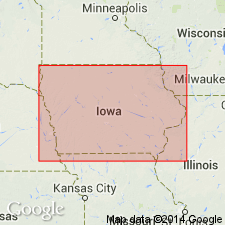
- Usage in publication:
-
- Big Springs limestone member*
- Modifications:
-
- Areal extent
Summary:
Pg. 20, fig. 5. Big Springs limestone member of Lecompton limestone. Thickness about 1 foot in Iowa, Missouri, and Nebraska; average about 2 feet in Kansas. Type locality stated. G.E. Condra, 1949, Nebraska Geol. Survey Bull., no. 16, p. 24. Commonly one massive light- to dark-gray argillaceous bed. Very fossiliferous in some outcrops. Thickness 1 to 1.5 feet. Underlies Queen Hill shale member; overlies Doniphan shale member. Age is Late Pennsylvanian (Virgilian).
Type locality: north of Big Springs, Douglas Co., northeastern KS.
Source: US geologic names lexicon (USGS Bull. 1200, p. 340).
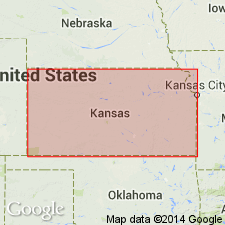
- Usage in publication:
-
- Big Springs Limestone Member
- Modifications:
-
- Overview
Summary:
(Paleozoic Era; Pennsylvanian System by J.M Jewett, H.G. O'Connor, and D.E. Zeller, p. 37.) Big Springs Limestone Member of Lecompton Limestone of Shawnee Group. Recognized in Kansas. A dark bluish-gray, yellowish-brown weathering, dense limestone. Commonly occurs as a single bed with closely spaced vertical jointing. Locally two or three limestone beds are separated by thin shale beds. Thickness 1 to 5 feet. Occurs above Doniphan Shale Member and below Queen Hill Shale Member, both of Lecompton Limestone. Fossiliferous (fusulinids). Age is Late Pennsylvanian (Virgilian).
Source: Publication.
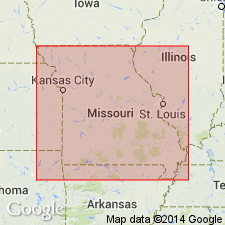
- Usage in publication:
-
- Big Springs Limestone Member
- Modifications:
-
- Overview
Summary:
Pg. 123 (fig. 36), 124. Big Springs Limestone Member of Lecompton Formation of Shawnee Group. Recognized in northwestern Missouri. Consists of a single bed of dark-gray, dense limestone that has an average thickness of about 1 foot. Overlies Doniphan Shale Member and underlies Queen Hill Shale member, both of Lecompton Formation. Age is Late Pennsylvanian (Virgilian).
Source: Publication.
For more information, please contact Nancy Stamm, Geologic Names Committee Secretary.
Asterisk (*) indicates published by U.S. Geological Survey authors.
"No current usage" (†) implies that a name has been abandoned or has fallen into disuse. Former usage and, if known, replacement name given in parentheses ( ).
Slash (/) indicates name conflicts with nomenclatural guidelines (CSN, 1933; ACSN, 1961, 1970; NACSN, 1983, 2005, 2021). May be explained within brackets ([ ]).

